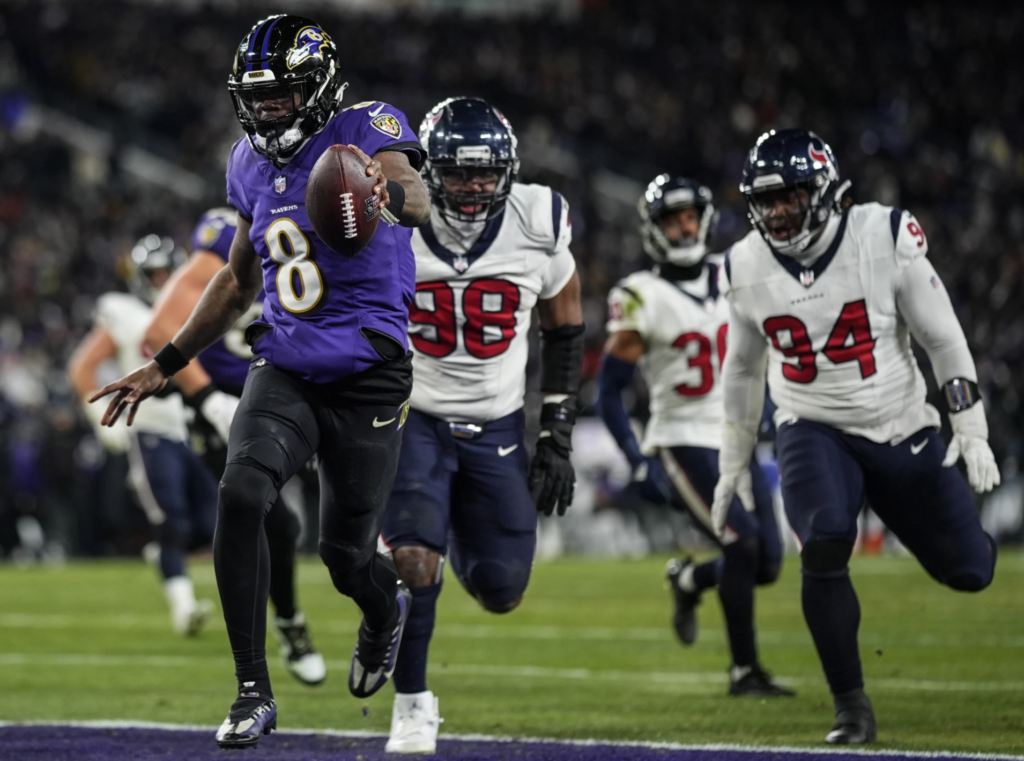How the Ravens Stopped the Red Hot Texans
HOW THE RAVENS STOPPED THE RED HOT TEXANS – Lamar Jackson has shed his albatross. But you might not have guessed it had you stopped watching at halftime.
Here We Go Again?
Through the first two quarters, Jackson seemed intent on pressing for the big play, to try and prove to the world he’s more than a regular-season phenom.
He held the ball for an average of 3.9 seconds, over a full second longer than his season average of 2.7 seconds. His aggressiveness proved costly against Houston’s blitz-heavy attack and the Ravens’ offense managed only 10 points. Entering the break, every Raven fan, myself included, was in a dark place.
Seeking clarity, I left my seat in the 500s section of the M&T Bank Stadium for a frigid stroll to get a view of the city and to collect my thoughts.
Horrible musings tormented me. “Maybe there’s just too much pressure on this team.” “Perhaps there’s some higher power restricting Lamar Jackson’s greatness to the regular season.” “Maybe God hates Baltimore.” I’ll admit I was being dramatic, but every other purple-wearing person in that place was thinking the same thing. Everyone except Lamar Jackson.
Dictating Houston’s Playstyle
Sparked by Devin Duvernay’s excellent kick return to open the third quarter, Baltimore’s offense took flight. Jackson diced Houston’s blitzes with quick throws, averaging 2.5 seconds between snap and pass in the second half.
He was poised, accurate, and in contrast to previous years, put in a position to succeed. Unlike Greg Roman’s 59-pass attempt disaster class back in the 2019 divisional round, Baltimore stuck with the run on Saturday.
Houston’s goal was to take away the pass, and they did it in the first half by running light personnel to match the Ravens’ speed. They played five or more defensive backs on 67 percent of first-half plays.
These lighter personnel groupings shut down Baltimore’s passing attack, holding the team to only 2.8 yards per pass.
Monkenomics
Fortunately, Todd Monken countered Houston’s DB-heavy defenses with a downhill running game that ripped off 7.6 yards per rush against these looks. Baltimore’s success on the ground forced Houston into heavier personnel groupings in the second half.
Houston leapt from running four or fewer DBs 33 percent of the time in the first half to 67 percent of the time in the second. Baltimore gashed these slower defenses with play-action and designed runs for Lamar Jackson.
He’s Still Got It
Lamar is not the same runner he was three years ago. But all that means is that he went from the greatest running quarterback ever to the greatest in the game today.
He showed on Sunday that he still has the speed to get the edge on a linebacker and give defenses fits. Jackson’s rush-heavy approach seemed to catch the Texans off guard after a season in which the quarterback used his legs sparingly.
On Sunday, the MVP turned back the clock rushing for 100 yards and two scores. Josh Allen and Patrick Mahomes run more in the postseason. Why shouldn’t Lamar as well?




